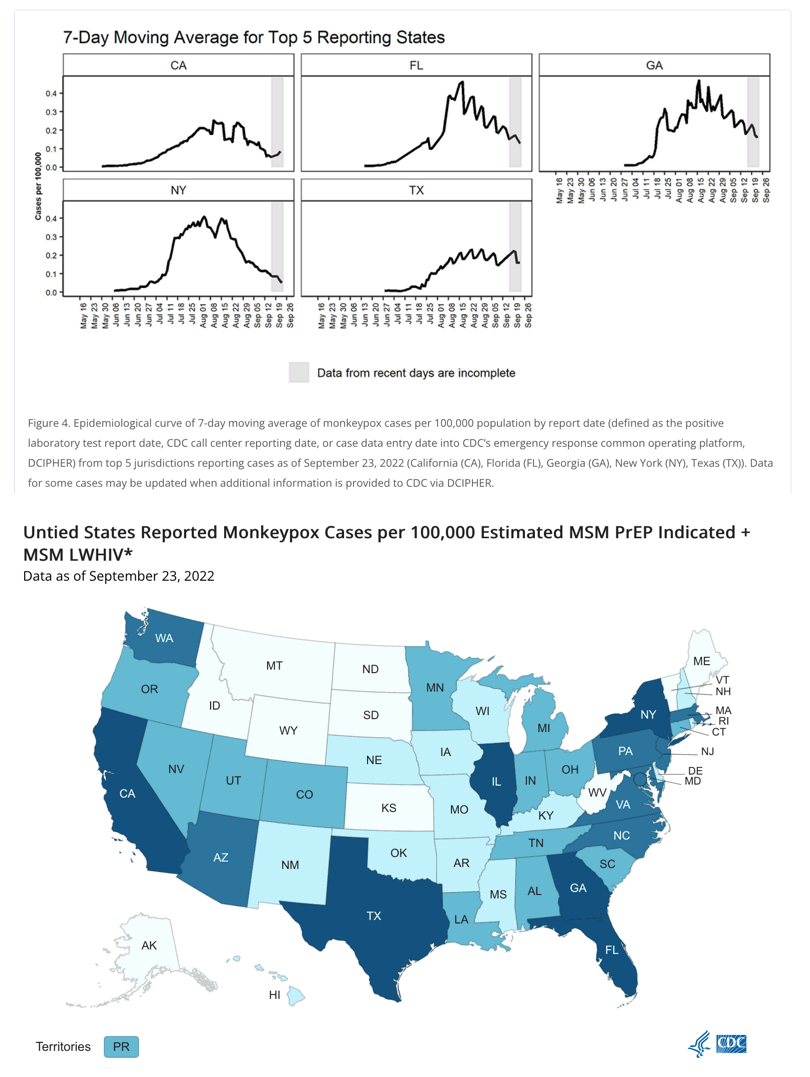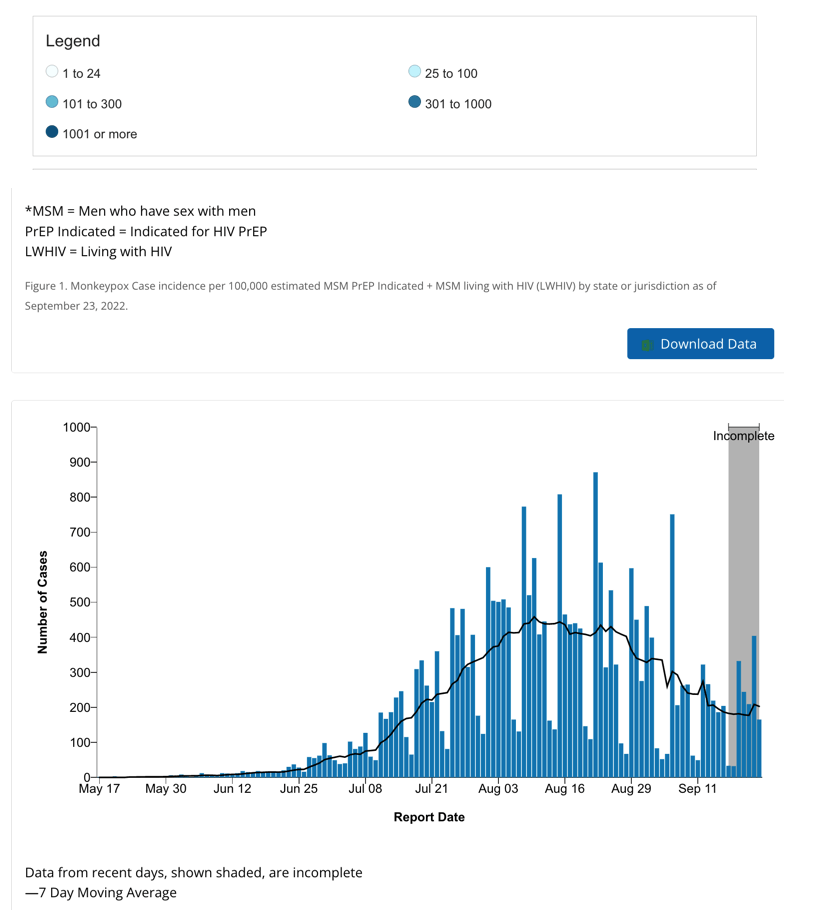| |
CDC- Future MPX Trajectory
|
| |
| |
Monkeypox eradication unlikely in the U.S. as virus could spread indefinitely, CDC says
Published Sat, Oct 1 2022 CNBC
Key Points
• The CDC, in a report, said monkeypox could spread indefinitely at a low level in the U.S.
• Monkeypox is unlikely to be eliminated from the U.S. in the near future, according to the CDC.
• The outbreak is slowing as the availability of vaccines have increased and people have become more aware of how to avoid infection.
The monkeypox virus is unlikely to be eliminated from the U.S. in the near future, according to a report published by the Centers for Disease Control and Prevention this week.
The CDC, in a technical brief, said the outbreak is slowing as the availability of vaccines has increased, people have become more aware of how to avoid infection, and immunity has likely increased among gay and bisexual men, the group most impacted by the virus.
But low-level transmission of the virus could continue indefinitely among men who have sex with other men, according to the report. The CDC said it does not have a projection of how many total people might get infected by the virus.
More than 684,000 people have received the Jynneos monkeypox vaccine so far. Earlier this week, the CDC reported preliminary data indicating that the vaccine is providing at least some protection against infection. The vaccination campaign is primarily focused on gay and bisexual men.
The outbreak could start accelerating again if the virus starts spreading widely among the U.S. population through heterosexual networks or contact that doesn’t involve sex, according to CDC. But there is no country in the current global outbreak that has found clear evidence of sustained spread of the virus outside sexual networks of gay and bisexual men, according to the CDC.
The public health agency also warned that the virus could start spreading faster again among people if it becomes established in an animal population in the U.S. The CDC said it is unknown which animals in North America are most susceptible to infection.
https://www.cnbc.com/2022/10/01/monkeypox-unlikely-to-be-eliminated-in-the-us-cdc-says.html
-------------------------------------
CDC - Technical Report 3: Multi-National Monkeypox Outbreak, United States, 2022 - Sept 29, 2022 Update
https://www.cdc.gov/poxvirus/monkeypox/cases-data/technical-report/report-3.html
Potential Future Outbreak Trajectory
Short-Term Scenarios
Possible outbreak growth scenarios for the United States over the next two to four weeks are the following:
1) Daily cases will continue to decline or plateau
2) Very slow growth with daily cases rising slowly
3) Exponential growth with daily cases rising rapidly
Among these scenarios, we assess daily cases in the United States will most likely continue to decline or plateau over the next two to four weeks. We have moderate confidence in this assessment but note the possibility, as described above, that incidence could increase again.
Our rationale for this assessment is based on the estimates of Rt below 1. However, we note cases are not declining in all jurisdictions. Because the causes of cases slowing in the United States and other countries are not well understood and patterns have not been uniform, we cannot predict the timing and precise trajectory of case declines in the United States.
Longer-Term Considerations
There is large uncertainty over the longer-term trajectory for the monkeypox outbreak in the United States, owing to a range of unknowns including the following:
• Detailed characteristics of sexual networks involving gay, bisexual, and other MSM and the impact of behavior change on outbreak trajectory among MSM
• Uptake and effectiveness of vaccines and other interventions on outbreak trajectory among MSM
• Pre-exposure and post-exposure vaccine effectiveness against infection and severe disease
• Potential for sustained transmission among non-MSM populations
• Extent and impact of asymptomatic spread of infection
• Potential impact of viral mutation on transmission dynamics
Our current assessment for the most likely longer-term scenario is that the outbreak will remain concentrated in MSM, with cases slowing over the coming weeks, and falling significantly over the next several months. We have moderate confidence in this assessment. We note that low-level transmission could continue indefinitely, and the cumulative number of cases that could occur among MSM is unknown.
We believe this scenario is most likely because the outbreak to date has remained concentrated among MSM. Monkeypox spread in other subpopulations has so far not been extensive, and there is no country in this outbreak with clear evidence of sustained transmission outside of MSM networks. While the declining proportion of cases reporting recent male-to-male sexual contact in the United States (Figure 6) and among MSM globally could signal potential for spread in other sub-populations, this finding is possibly an artifact due to missing data, as discussed above. We also make this assessment assuming monkeypox infection provides strong immunity to subsequent infection, as is the case for other orthopoxviruses, which will eventually lead to a depletion of susceptible individuals among populations disproportionately affected.
We note that mathematical models have shown considerable variability in predicted levels of cumulative incidence among MSM (Brand et al. 2022; Endo et al. 2022; van Dijck et al. 2022; personal communication and internal modeling results). The duration of the intense transmission phase for this outbreak is also highly uncertain. If spread is concentrated among a high-risk subset of MSM, and vaccination is well focused in this exposure group and strongly protective against infection, a more rapid decline and lower cumulative number of cases could occur (Badham and Stocker 2010). If, however, spread is less concentrated among a high-risk subset of MSM, or vaccination and behavior change only gradually slow spread, a cumulatively high number of MSM infections and a long outbreak tail are possible.
Given our uncertainty over how the monkeypox outbreak may unfold in the United States, we acknowledge several other less likely but possible scenarios that could transpire, some of which could require major shifts in our outbreak response posture.
Elimination: Domestic transmission in the United States is unlikely to be eliminated in the near future. While unlikely, elimination could occur if monkeypox is and remains concentrated in a high-risk subset of MSM, and vaccination efforts are focused on this exposure group and are effective in preventing infection, both factors which would cause faster declines in transmission. However, we view this scenario as unlikely due to the possibility of continued introductions and onward transmission.
Acceleration: The monkeypox outbreak could accelerate in the United States over the next several months and affect an increasingly wider segment of the United States population. This scenario is most likely to transpire if transmission occurs more readily than expected among non-MSM populations including potentially among highly connected heterosexual networks or by non-sexual routes.
Establishment in animal populations: There is a possibility that the monkeypox virus could establish itself in one or more animal populations in the United States, although this scenario would require that a suitable reservoir animal host exists, which is currently unknown. If such a reservoir host exists, this scenario could become more likely as case numbers rise. Several animal species in North America, both wild and domestic, may be susceptible to monkeypox infection and may be able to transmit the virus to other animals or species.


|
|
| |
| |
|
|
|